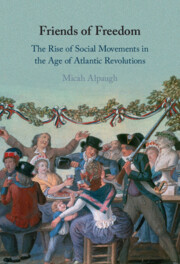Book contents
- Friends of Freedom
- Friends of Freedom
- Copyright page
- Contents
- Acknowledgments
- Introduction
- Part I The American Revolution Ignites Social Movements
- 1 The Sons of Liberty and the Creation of a Movement Model
- 2 From Boycott Mobilization to the American Revolution
- 3 Wilkes, Liberty, and the Anglo-American Crisis
- 4 The British Association Movement and Parliamentary Reform
- 5 The Irish Volunteers and Militant Reform
- 6 Religious Freedom, Political Liberty, and Protestant Dissenter Civil Rights
- 7 The Rise of American Abolitionism
- 8 British Abolitionism and the Broadening of Social Movements
- Part II The French Revolution Radicalizes Social Movements
- Bibliography
- Index
1 - The Sons of Liberty and the Creation of a Movement Model
from Part I - The American Revolution Ignites Social Movements
Published online by Cambridge University Press: 29 October 2021
- Friends of Freedom
- Friends of Freedom
- Copyright page
- Contents
- Acknowledgments
- Introduction
- Part I The American Revolution Ignites Social Movements
- 1 The Sons of Liberty and the Creation of a Movement Model
- 2 From Boycott Mobilization to the American Revolution
- 3 Wilkes, Liberty, and the Anglo-American Crisis
- 4 The British Association Movement and Parliamentary Reform
- 5 The Irish Volunteers and Militant Reform
- 6 Religious Freedom, Political Liberty, and Protestant Dissenter Civil Rights
- 7 The Rise of American Abolitionism
- 8 British Abolitionism and the Broadening of Social Movements
- Part II The French Revolution Radicalizes Social Movements
- Bibliography
- Index
Summary
Whereas Americans had quickly won redress amid the Stamp Act controversy, over the following decade the use of similar, affiliated social movement organizations exacerbated rivalries with Britain and eventually mobilized the War of Independence. First, colonists responded to the hated Townshend Acts of 1767 with boycotting associations that sought to overturn the measure through economic warfare – that only led to partial changes. American rights became a partisan issue with Britain, as colonial patriots increasingly allied with the Wilkes and Liberty movement. The enduring tax on tea and the colonial resistance it inspired in 1774 motivated British passage of the Coercive Acts, that militarized the colonial networks and led them to prepare for war. Committees of Safety and Security seized power in many locales and proved integral in mobilizing the civil war against the British.
Keywords
- Type
- Chapter
- Information
- Friends of FreedomThe Rise of Social Movements in the Age of Atlantic Revolutions, pp. 19 - 43Publisher: Cambridge University PressPrint publication year: 2021

